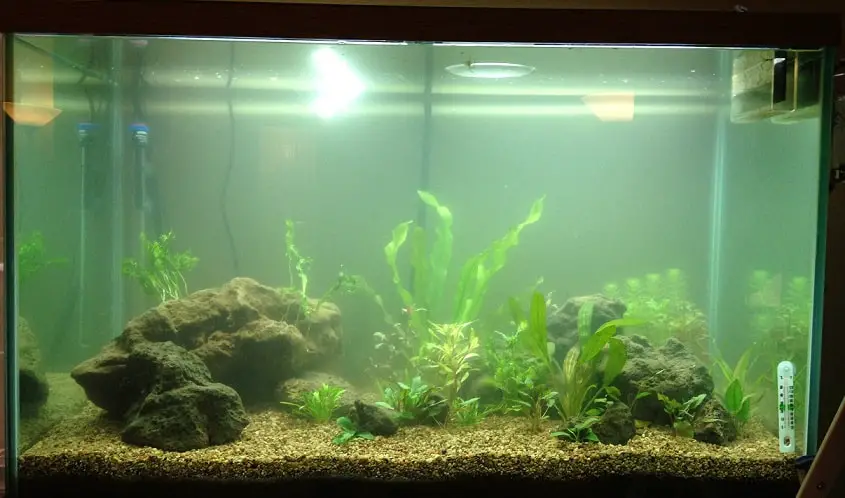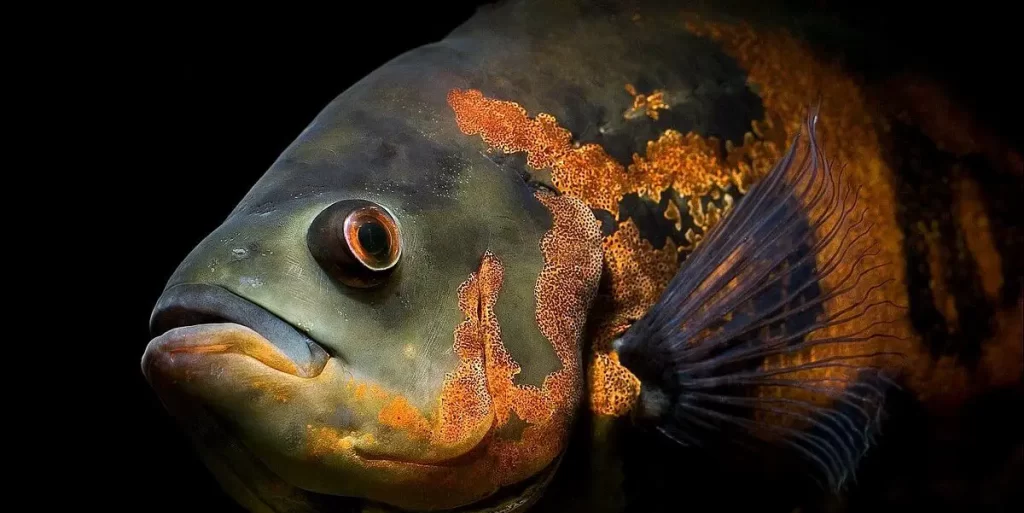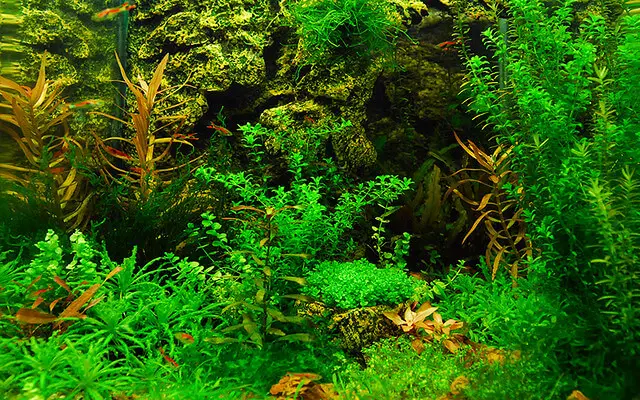As I looked at my fish tank, I saw something strange. The water that used to be so clear was now cloudy and murky. I couldn’t even see my fish properly anymore. I wanted to figure out what was going on and how to make the water clear again. That’s where our journey to solve the ‘Cloudy Aquarium Water’ mystery begins.
Quick Answer:
A cloudy aquarium is when the water gets all murky, making it tough to see your fish and decorations. It usually happens if you feed your fish too much, don’t have a good filter, or if there are too many bacteria. To stop it, try not to overfeed, use a good filter, and keep an eye on the water quality in your tank. These steps will help keep your aquarium water clear and your fish happy.
In this guide, we’ll explore effective solutions to clear up your aquarium and provide your fish with a crystal-clear, healthy environment. So let’s jump right in and discover why the water gets cloudy, so you can say goodbye to that fuzzy mess and create a sparkling paradise for your aquatic buddies.
What Is Cloudy Fish Tank Water?
Let’s explore what cloudy water in a fish tank means. Essentially, it occurs when the water in a freshwater aquarium lacks the desired clarity and instead appears hazy, foggy, murky, or cloudy. Unfortunately, many fish keepers face this common problem, which can make the tank look unattractive and dirty, raising concerns about the fish’s well-being.
Various factors usually cause cloudiness in your fish tank water. These factors can include an excess of organic material, high levels of bacteria or algae, or an imbalance in the water’s chemistry. Sometimes, it indicates poor water quality, harming fish and other aquatic creatures. That’s why it’s important not to ignore cloudy water. Instead, it’s crucial to monitor water quality and take prompt action to address the issue.
What Are The Types of Cloudy Water?
Cloudy water in an aquarium can have different colors and indicate different problems. Understanding the type of cloudy water is important to determining the root cause and taking the right approach to fix it. Let’s look at the most common types of cloudy water in a fish tank. They are as follows:
1. White or Grayish Water

The occurrence of white or grayish water in a fish tank is a common issue that can be problematic for fishkeepers. Instead of clear water, it might look like someone poured milk or mixed flour into it, making it hard to see anything in the tank. Well, this cloudy water is called a bacterial bloom. So let me explain what’s happening.
You see, organic materials in the tank act as a food source for bacteria. When these materials are excessed, bacteria multiply rapidly, causing the water to turn cloudy. Factors like poor filtration or overfeeding can also contribute to this issue.
So, in simple terms, when the water in your fish tank becomes white or grayish, there’s a bacterial bloom. This happens when there’s too much food for the bacteria to feast on. Keeping a good balance and proper filtration can help to prevent this cloudiness and keep your fish tank healthy and clear.
2. Green Water
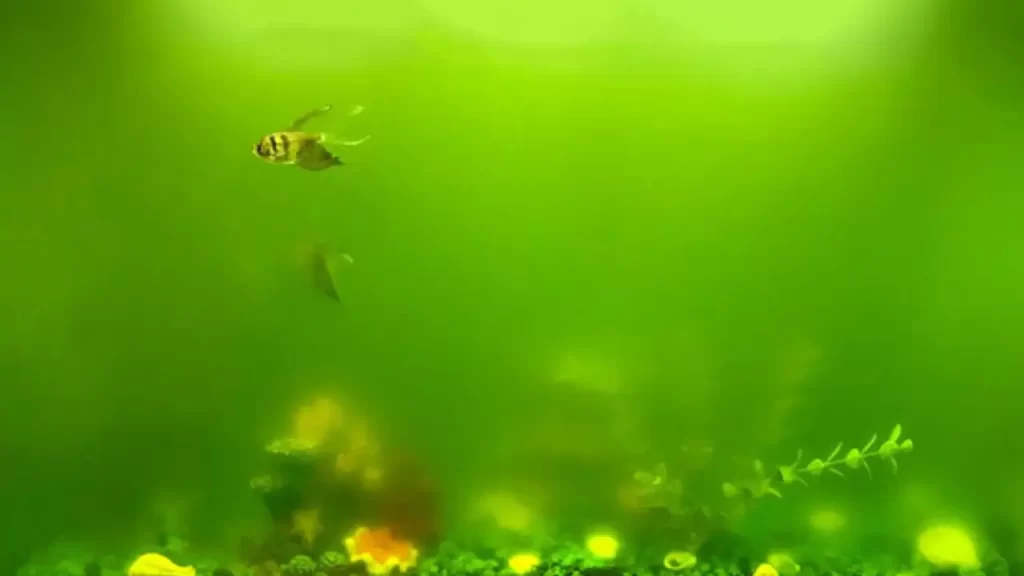
The vibrant green transformation of your fish tank water, resembling a miniature pond, occurs due to specific factors. The water takes on a vibrant green color and becomes extremely difficult to see through. But don’t worry. I’ll explain what’s causing this phenomenon.
You see this green water results from an algae bloom. It means that the algae in your tank are multiplying rapidly, almost like they’re having a growth spurt! Unlike other types of algae that stick to surfaces, these particular algae float freely in the water column.
Algae blooms can occur easily and quickly, especially under the right conditions. Algae require sunlight and nitrogen to grow; when these conditions are just right, they can reproduce remarkably. However, while the algae themselves don’t directly harm your fish, they can lead to various issues like reducing oxygen level in a tank which harms your fish.
So, to sum it up, when your fish tank water turns bright green and becomes hard to see through, it’s because of an algae bloom. These algae are multiplying rapidly due to the presence of sunlight and nitrogen. So, taking proper care to prevent and manage this green water situation is essential to keep your fish tank healthy and clear.
3. Yellow or Brown Cloudy Water
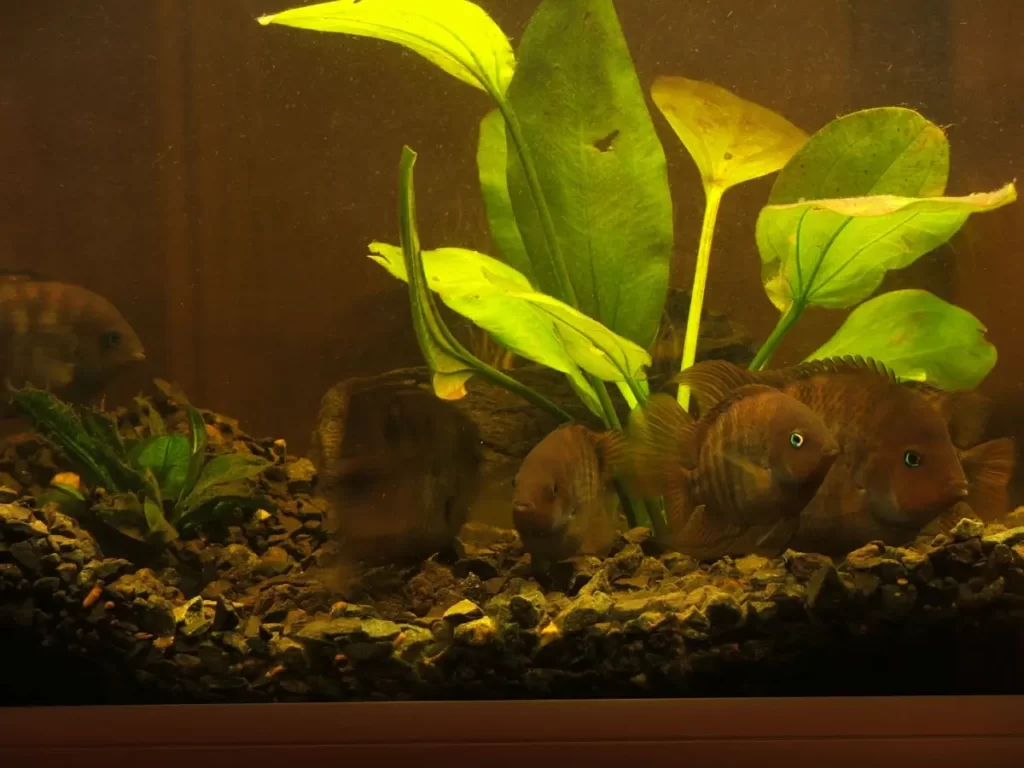
Sometimes, the water in your fish tank can turn yellow or brown, looking like a cup of tea with too much milk. This is not the ideal appearance for your aquatic pet’s home. However, some aquarists purposely create this colored water to achieve an aesthetic and natural vibe.
When it comes to this cloudy water, the usual culprit is an excess of organic materials, like driftwood, leaves, or other debris. These materials release tannins, which impart a yellow or brown tint to the water. Understanding the causes behind this yellow or brown cloudy water is crucial for addressing the issue and ensuring a healthy environment for your fish.
It’s different from what you had in mind, but it’s worth knowing that this coloration can be intentional for some aquarists. However, when the water turns yellow or brown due to an excess of organic materials, it’s essential to take action to maintain a healthy and clean environment for your fish.
Common Causes of Cloudy Water in an Aquarium
A variety of factors can cause cloudy water in an aquarium. So, here are some of the causes that can result in different types of cloudiness, ranging from milky white or grayish water to green or yellow-tinted water or even water that appears to have a layer of fine particles suspended in it. They are as follows:
1. Overfeeding
Feeding your fish excessively is a frequent suspect behind cloudy water in an aquarium. When you provide them with too much food, the surplus breaks down, generating abundant organic material in the water.
Consequently, the delicate balance of your aquarium’s ecosystem is disrupted, potentially leading to a bacterial bloom that causes the water to turn cloudy. To address this issue, offering your fish smaller portions of food throughout the day is advisable rather than one large feeding session.
2. Inadequate Filtration
Proper filtration is vital for keeping your aquarium environment healthy and ensuring your fish survive. Therefore, it’s essential to select the right filter for your tank and ensure it is functioning effectively.
One of the reasons aquarium water becomes cloudy is due to insufficient filtration. You can consider using a quality filter such as the Biomaster Thermo. This filter offers excellent performance, comes reasonably priced, and includes multiple foam densities to enhance efficiency.
3. New Tank Syndrome
New tank syndrome is a common problem when people set up a new aquarium without giving enough time for helpful bacteria to grow. This can cause ammonia and nitrite levels to increase, which makes the water look cloudy or milky. Following instructions or seeking expert advice is important when starting a new aquarium.
Wait a few days for the nitrogen cycle to finish before adding fish or other aquatic animals. This is important for keeping your fish and other creatures healthy and happy.
4. Algae Blooms
Algae blooms are a common reason why the water in fish tanks becomes green and cloudy. These blooms occur when Euglena algae cells are excessively grown, which have flagella to move around and depend on light for photosynthesis.
Algae can take over the tank if an imbalance is caused by too many fish, excessive light, or abundant nutrients. So, to tackle this issue, you can employ a diatomic filter or UV filtration to eliminate the algae cells and minimize the green color in the water.
5. Bacterial Blooms
Bacterial blooms are natural in aquariums when bacteria that convert nitrogen colonize and begin oxidizing ammonia and nitrites. This process is important for creating a balanced and thriving environment for fish and other aquatic creatures.
However, heterotrophic bacteria can multiply rapidly if there is a sudden rise of nutrients, like excessive food or waste. These bacteria can create a slimy biofilm that covers surfaces, leading to cloudy water. Therefore, it is recommended to maintain proper aquarium maintenance, including regular water changes and monitoring nutrient levels in your aquarium.
6. Chemical Imbalances
Chemical imbalances can cause problems in your fish tank. For example, high nitrate and phosphate levels can cause too much algae to grow, making the water turn green or brownish.
Conversely, low pH levels can create acidic conditions that dissolve minerals and make the water appear murky. The best method you can adopt is to test the water parameters regularly and ensure the chemical levels are balanced.
If there is an imbalance in the levels, you can take appropriate corrective measures, such as implementing water treatments or adjusting the tank’s filtration.
7. Insufficient Water Changes
More water changes can lead to issues in your aquarium. When you let uneaten food, fish waste, and other organic materials accumulate in the water, it can cause a decline in water quality and an increase in nutrients.
As time goes on, this buildup can cause the water in your aquarium to become cloudy or discolored. Therefore, regularly removing any uneaten food and debris from the substrate must be regularly removed using a fish net along with regular partial water changes.
8. Medications
Adding medications to your aquarium can sometimes make the water cloudy or change its color. This occurs because the chemicals used in medication can affect the water’s chemical balance.
Antibiotics and antifungal medications, in particular, are known to cause this problem. Therefore, ensure you carefully follow the veterinarian’s instructions and provide the recommended dosage when using medications in your aquarium.
9. Dirty Decorations Or Substrates
When debris, waste, or uneaten food accumulates on decorations or settles in the substrate, they can break down and release organic compounds into the water. These organic compounds serve as a nutrient source for bacteria, increasing bacterial growth. This bacterial bloom can result in cloudy or murky water.
So, make sure you thoroughly rinse the decoration and vacuum the substrate to prevent the formation of cloudy or milky water. This will help remove any loose particles that could contribute to cloudy water.
10. Inadequate Oxygenation
Insufficient oxygenation is one of the reasons behind cloudy water in an aquarium. When there is not enough oxygen available in the water, it can lead to the accumulation of organic matter and waste.
Furthermore, insufficient oxygen levels create an environment where beneficial bacteria struggle to break down organic compounds effectively. As a result, the undecomposed waste particles remain suspended in the water, leading to cloudiness.
Utilizing air stones, powerheads, and a reliable filtration system is advisable to ensure adequate oxygenation and water flow in the aquarium. This will help to maintain a clear and healthy aquatic environment for your fish.
Signs And Symptoms Of Cloudy Water To Look Out For
Dealing with cloudy water in an aquarium can be a real headache for fish keepers. But there are some signs and symptoms you can look out for. They are as follows:
1. Cloudiness Or Haziness Of Water
If your water looks cloudy or hazy, it could indicate several issues like bacterial bloom, excess food or waste, or a problem with your filtration system. In addition, cloudiness can obscure your fish and plants, making it difficult to see them clearly, and it can also indicate poor water quality that could harm the health of your aquatic life.
2. Discoloration Or Tint To The Water
You may see your tank water changing to yellow, green, or brownish-colored water. This discoloration can signify tannins or other organic compounds leaching from the tank’s driftwood, plants, or other materials. Sometimes, algae or other types of microbial growth can also cause the water to take on a different color.
3. Algae Growth
Algae are small, photosynthetic organisms that can rapidly reproduce under the right conditions, such as excess light and nutrients. While some algae growth is healthy and normal for an aquarium, excessive algae can indicate poor water quality or an imbalance in the tank’s ecosystem.
4. Unusual Odor
An unusual or unpleasant odor released from your aquarium can strongly indicate an underlying issue. The smell could be caused by decaying organic matter, excessive waste, or bacterial growth. Saling an odor similar to a rotten egg could be a sign of sulfur compounds. At the same time, a fishy smell might indicate poor water quality.
5. Changes In Fish Behaviour
If your fish seem more sluggish than usual or have lost their appetite, it could indicate poor water quality or illness. Abnormal swimming patterns or gasping for air at the water’s surface could be a sign of low oxygen levels or toxins. You should monitor the fish tank regularly and note their activities.
6. Abnormal Growths On Fish Or Plants
If you notice unusual growths or abnormal physical changes in your fish or plants, they may indicate a sign of disease or infection. Factors such as poor water quality, inadequate nutrition, or harmful pathogens can cause these growths. If left untreated, these conditions can quickly spread and pose a life-threatening risk to your aquatic pets.
Impacts of Cloudy Water on Fish
Cloudy water can negatively impact tanks, including fish, and their overall health. Here are some of the ways that cloudy water can affect fish:
1. Oxygen Deprivation
Cloudy tank water can hurt the fish that live in the tank. One of the main concerns is decreased available oxygen levels, which can result in various problems like stress, illness, and even death. The reason for this is that cloudiness often occurs due to an excess of organic waste, which consumes oxygen during decomposition. The lack of oxygen can stress the fish and weaken their immune systems, making them more vulnerable to diseases and other health problems.
2. Bacterial And Fungal Infections
There is a high risk of bacterial and fungal infections to fish in a cloudy water tank. When the water quality is poor, fish are more susceptible to diseases and infections. Also, if the fish have any open wounds or injuries, cloudy water can provide a breeding ground for harmful bacteria and fungi. This can lead to infections, which can be difficult to treat and may even result in the death of the fish.
3. Ammonia And Nitrite Poisoning
When there is too much organic matter in the aquarium water, it can lead to the accumulation of ammonia and nitrite. These chemicals are toxic to fish and can cause various negative effects, including reduced activity, loss of appetite, and struggle to breathe. In severe cases, it can even be fatal for the fish. So, you should take action to ensure a healthy and safe environment for your aquatic pets.
4. Stress
When fish are exposed to cloudy water for a long period, they can experience stress. This can weaken their immune system and make them more vulnerable to illnesses. Also, poor water quality can cause fish to behave abnormally, such as with increased aggression or hiding more frequently. Moreover, it can also result in abnormal fish growth and shorten their lifespan.
How To Prevent Cloudy Water In An Aquarium?
To ensure your aquarium water remains clear and free of cloudiness, it’s essential to take proper care and maintenance of your tank. Several factors must be considered, and consistent attention is required to maintain a healthy and living aquatic environment for your fish and plants. Some of the ways to prevent cloudy water in your aquarium are as follows:
1. Don’t Overfeed The Fish
Having fish as pets is enjoyable, but we must exercise caution regarding their feeding. Sometimes, overfeeding can result in a dirty and cloudy tank. This occurs because tiny bacteria thrive on leftover food and fish waste.
When these bacteria multiply excessively, they cause the water to appear dirty and unclear. Therefore, it is important to ensure that you feed them an appropriate amount and regularly clean their tank.
2. Don’t Crowd The Tank
When you overcrowd or have too many fish in a new aquarium, it can also make bad chemicals called ammonia and nitrite go up and harm your fishy friends. So, it’s important to look at the size of your fish tank and adjust the fish size accordingly. Then, avoid too many fish in your tank and provide your fish with a clean, happy, and healthy home.
3. Perform Regular Water Changes
To keep the water fresh and safe for your fish, you can change a small amount of water daily or every other day. This practice helps remove any excess waste or debris that might have built up in the water, ensuring the happiness and health of your fish.
4. Use A Good Quality Filter
A filter cleans the water and makes it a healthy and happy home for your fish. Make sure you choose a strong filter for your tank size. A powerful filter can help remove harmful substances from the water and keep the environment safe for your aquatic pets. So when choosing a filter, ensure it has a high filtration power to keep your aquarium sparkling clean.
5. Improve Quality Of Light And Reduce Lighting Times
You should ensure the light isn’t too bright or dim for your fish and plants and reduce the time the light is on each day. This will help prevent algae growth and keep your aquarium looking great.
6. Don’t Overuse Chemicals
It’s important to be cautious with chemicals in your fish tank. Only use them in emergencies, and never use them excessively. Chemicals can mess up the balance of your tank and lead to problems like cloudy water. So, it’s always better to avoid using chemicals and focus on alternative methods unless necessary.
7. Use Activated Carbon
The activated carbon helps to remove impurities and absorb nutrients that feed the bacteria bloom, which in turn helps to clear the water. Follow the manufacturer’s instructions for how much activated carbon to add and how often to replace it.
8. Use Live Plants
Adding live plants to your fish tank can be a great idea. They not only add beauty and color to your aquarium but can also help prevent cloudy water by absorbing some of the excess nutrients the bacteria feed on. Also, live plants provide natural hiding spots and resting places for your fish, reducing their stress and making them feel more at home.
9. Cycle Your Aquarium
Before adding fish to your new aquarium, letting the tank go through a complete nitrogen cycle is important. This process helps build up good bacteria that will help keep your fish healthy. The cycle may take a few weeks to complete, so be patient.
During this time, you don’t have to do anything special. Let the tank sit with the water and filter running. It’s like a little ecosystem that needs time to balance itself. So don’t rush it. Let nature do its thing.
10. Test Aquarium Water
To ensure that everything is okay with your aquarium, you can use a test kit to check the ammonia and nitrite levels in your water. If the levels are zero, then there is nothing to worry about. However, being patient and letting your tank settle independently is important.
Avoid adding more fish to your tank and only feed your fish every other day to prevent overfeeding. Also, it’s best not to touch your filter or add chemicals to your tank, as this may disrupt the natural balance.
Cleaning and Maintenance Tips for Aquariums
Regular cleaning and maintenance are essential to keep your aquarium healthy and your fish thriving. Here are some tips for cleaning and maintaining your aquarium:
1. Set A Regular Cleaning Schedule
Creating a regular cleaning schedule is important to maintain a healthy environment for your aquarium and ensure the well-being of your fish. You should change the water in your tank every week or two to remove any accumulated waste or debris. At the same time, you should test the water parameters and make any necessary adjustments.
It is also important to clean your aquarium filter monthly to prevent clogging and ensure proper water flow. Lastly, you must clean the decorations and substrate to remove any debris accumulated in hard-to-reach areas.
You will need the right equipment and tools to make a big difference in your aquarium. For example, a siphon hose helps change water by removing water and debris from the bottom of the tank without messing with your fish.
If you’ve got some stubborn algae or buildup on your tank walls or decorations, an algae scrubber or scraper can help you eliminate it. Moreover, a fish net is perfect for removing any debris or fish that need to be taken out for maintenance or cleaning.
2. Test The Water Quality
If you want to keep your aquarium water in tip-top condition and ensure the health of your fish, it’s super important to test the water regularly using a test kit. You can keep your eyes on the levels of pH, ammonia, nitrite, nitrate, and other important parameters.
I recommend you test the tank water at least once a week or even more often if you have a new or heavily stocked tank. This activity will help you catch any issues early and take action to fix them, like doing a water change or adjusting the pH level.
3. Maintain The Aquarium Equipment
You should clean your aquarium equipment and regularly inspect them to ensure they are functioning properly. Look at your filters, heaters, air pumps, and any other equipment in your tank to ensure they are running smoothly. If you notice any worn or broken parts, it’s important to replace them as soon as possible to avoid any potential issues down the line.
Always following the manufacturer’s instructions for cleaning and maintenance is essential to ensure your equipment stays in good condition and lasts for a long time.
Through these cleaning and maintenance tips, you can help ensure a healthy living environment for your fish and other aquatic inhabitants. In addition, it will lead you to a more enjoyable and fulfilling aquarium experience.
How Often Should I Perform Water Changes To Prevent Cloudy Water In My Aquarium?
Performing regular water changes is crucial to prevent cloudy water in your aquarium and keep your fish healthy. It’s like giving your fish a fresh and clean home to live in. Water changes help to remove harmful toxins and waste buildup that can occur over time. They also refill essential minerals and nutrients that may become depleted.
The frequency of water changes depends on factors like your tank size, the number of fish, and the substances present. As a general guideline, performing a 10-15% water change every week or a 20-25% water change every other week is recommended. However, more frequent water changes may be necessary if your tank is heavily stocked or has a high bio load.
It’s essential to avoid changing too much water at once, as it can stress your fish and disrupt the tank’s balance. Never change more than 50% of the water in your tank in one go. Also, gradually change the water temperature and pH levels to prevent unnecessary stress on your fish. Remember, the well-being of your fish should always be your top priority when performing water changes.
Frequently Asked Questions(FAQs)
Here are some of the frequently asked questions related to cloudy water in an aquarium, they are as follows:
Can A Dirty Filter Cause Cloudy Water In My Aquarium?
Yes, a dirty filter can cause cloudy water in your aquarium. The filter plays an important role in removing excess food, debris, and waste from the water. With time, the filter can become clogged with accumulated waste, hindering its ability to function effectively. As a result, water circulation and filtration can be adversely affected, leading to cloudy water. It’s important to clean the filter regularly to maintain optimal water quality in your aquarium.
Can Using A UV Sterilizer Help Prevent Cloudy Water In My Aquarium?
Yes, UV sterilizers can help prevent cloudy water in your aquarium. The UV sterilizer employs ultraviolet light to kill microorganisms such as bacteria, viruses, and algae in the water that passes through it. By eliminating these microorganisms, UV sterilizers can inhibit algae growth and lower the chances of bacterial or viral infections in your aquarium.
Can Adding Salt To My Aquarium Prevent Cloudy Water?
Adding salt to your aquarium may help prevent cloudy water, but it’s not a guaranteed solution. While it can help reduce the growth of certain types of bacteria and parasites, it’s important to remember that it may not work for all cases. Also, you should consider the negative effects it can have on some fish and plants.
Conclusion
Sometimes, the water in your fish tank can get cloudy, which can be dirty and harmful to your fish. But you do not have to worry now as there are things you can do to prevent it. Make sure you only have a few fish in your tank and only feed them a little bit every other day. Use a good quality filter, live plants, and activated carbon to help keep the water clean. And be sure to do regular water changes. Caring for your fish tank will make your fish happy and healthy.
Our article has helped you understand why your aquarium water may become cloudy and how to prevent it. First, however, it’s important to remember the causes we’ve discussed to avoid cloudy water in the first place.

